I begin with the story of two avocado trees grown from seed. These trees are related yet separated by about ten miles and eighty years — and they illustrate a thing or two about what kind of tree you can expect when you plant an avocado seed.
Seedling avocado tree number one
In 1926, a man named Rudolph who lived in a rural part of Los Angeles County bought and planted many sprouted avocado seeds on his sloped property. He intended to let those seeds grow for a while and then graft the young trees to the best avocado variety of that era, the Fuerte. Rudie, as friends called him, mostly succeeded in that. One exception was a seedling tree that never took to the graft attempts and instead eventually started making its own fruit, which was peculiar compared to the Fuerte.
The fruit had pebbled skin. It was ready for picking in the summer, and once picked the green skin turned purple as it ripened. Cut open, you’d find a smallish seed. And the tree produced lots of this fruit, year after year (a great improvement upon the erratically bearing Fuerte). Oh yeah: the creamy flesh inside had no fiber and an excellent nutty flavor.
Rudie decided that his tree was so good overall that he applied for a patent, and on August 27, 1935 he was awarded plant patent 139. He named the avocado after himself, his full name being Rudolph Gustav Hass.
(See a photo of the Mother Hass avocado tree when it was 19 years old here.)
(See the original Hass avocado patent here.)
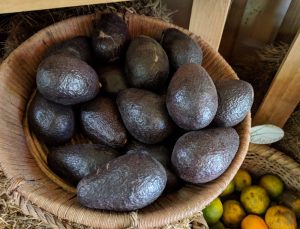
Rudolph’s avocados are now eaten around the world, these ones being for sale in a market in Costa Rica.
Seedling avocado tree number two
In 2007, a few cities away in Los Angeles County, a seed from a Hass avocado sprouted out of the compost heap in my mom’s backyard. She allowed it to grow, and grew and grew it did. In fact, it quickly rocketed up to near twenty feet.
In the spring of 2013, the tree flowered. Fruit started to grow. And then we began test-picking it, not knowing what it should look like when it was mature.
See, the fruit didn’t look like Hass fruit. Although the tree grew from a seed inside a Hass fruit, the fruit on my mom’s tree had smooth, thin green skin with little yellow dots. Then as it hung on the tree longer, the skin did start to turn black like Hass. Would the inside look more like Hass?
The flesh was slightly greener than Hass, and although the taste was excellent, it had some fiber. In subsequent years, this stringiness has reduced, but it is still not as smooth as Hass. Nor is the seed as small as Hass.
It’s a decent avocado. One particularly convenient quality of the fruit, we’ve found, is that it is near prime in flavor around Thanksgiving, which is earlier than many other avocado varieties in Southern California, including Hass.
So the tree is a keeper although it is not nearly so good that my mom is about to apply for a patent.
Avocado genetics are variable
What can you expect if you plant an avocado seed? Since most avocados eaten in the world today are Hass, let’s say it’s a Hass seed that you plant. The short answer is, expect the unexpected.
“For the Hass, like most avocado lines, carries much hidden genetic variability (“heterozygosity”). So it is impossible to predict its breeding behavior.” So wrote Bob Bergh, who was a plant breeder at the University of California, Riverside, and who ran their avocado breeding program for four decades, and who probably grew more avocado seedlings than any other human to this day.
Bergh observed this genetic variability over and over again, most strikingly after planting seeds from Hass fruit that were as purely Hass as possible. He caged Hass avocado trees and put bees inside the cages so they would pollinate the flowers but there was no chance of cross-pollination by other nearby avocado varieties. Then he planted the seeds of the fruit that resulted from that caged, self-pollination — just over 300 seeds.
He reported some of the results in 1973 in a paper titled, “Self-pollinated Hass Seedlings.” You must look at the photos of the fruit shown in that paper. Click the link and then come back. You won’t believe the variation you see.
(Also check out the differences in trees that came from seeds of an old variety called Puebla in this article: “Notes on the Fruits of Seventy-five Puebla Seedlings.”)
While Bergh did discover that some of the seedling trees eventually bore fruit that looked a lot like Hass, others bore fruit with giant seeds, and some fruit had long necks, or were totally round, or tiny, or never turned purple black, or had strange ridges on their skin, or were ready to eat in the winter (like my mom’s Hass seedling fruit). “Who would have thought that beautifully formed ‘Hass’ was hiding these monstrosities in its genes!” wrote Bergh.
So when you plant your Hass seed, an avocado tree will grow that will produce fruit of unknown, unpredictable characteristics.
Is the Hass variety unique in this respect? Hass does apparently have more genetic variability than some other avocado varieties, but no avocado variety’s seedlings will produce fruit exactly like the parent.
Bergh: “We have looked at thousands of avocado trees produced by selfing and have never found two from a given parent that were identical or even close to it.”
This is good news, of course. It allows for the possibility of improvement.
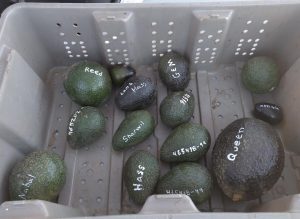
Plant the seeds of any of these avocados and only one thing is sure: the fruit you’ll get from that tree will be something new.
(Then how are the named avocado trees we buy at nurseries made, if not by growing seeds? They are grafted, usually onto seedling trees. See my post, “Your fruit trees are grafted — Why? And so what?”)
How long until a seedling avocado tree produces fruit?
But how long until you know if your seedling avocado tree is better or worse than its parent — that is, how long until a seedling avocado tree fruits?
My mom’s seedling avocado tree made fruit six years after it sprouted. Rudolph Hass’s seedling tree reportedly fruited sooner than that, but out of all of the seedling avocado trees that I’ve seen or heard of, in general, fruiting usually happens in 5-10 years.
I have read of seedling avocado trees that “never” produce fruit, but I’m not sure how long these trees were given the opportunity to fruit before being pronounced barren. I do know that in his breeding program, Bob Bergh said that if a seedling hadn’t produced fruit within 10 years he removed the tree.
I know of some old seedling avocado trees that rarely have fruit, and when they do they have very few. But I can’t say that I’ve ever seen an avocado tree that never fruited. Then again, if a tree takes more than ten years to have any fruit, and then it has very few fruit in subsequent years, it’s not much of an avocado tree; it might as well be called a shade tree.
Regardless, it should be remembered that all avocado varieties are more or less fruitful, and precocious. Some flower and produce fruit when they’re very young, such as Gwen, while others are notoriously slow at beginning to fruit, such as Fuerte. And some, like Pinkerton, consistently make more fruit than most other avocado varieties.
Another reason not to cut down my mom’s seedling tree: it makes a lot of fruit, consistently.
Will a seedling avocado tree produce good fruit?
Whether or not you find your seedling avocado tree’s fruit good depends on your standards. While it is highly unlikely that the fruit will be inedible, the likelihood is exceedingly slim that it will produce fruit that is as good as today’s best varieties. This should be obvious if we just remember how these preferred varieties rose to that status.
In Southern California alone, people have been growing seedling avocados for a long time. Way back in 1915, Wilson Popenoe described 86 most-promising avocado varieties. Only one year later, in 1916, Ira Condit had 140 avocado varieties of interest to describe. That was over a century ago now. In the interim there have been hundreds of thousands of seedling avocado trees grown and assessed and fruit tasted. Varieties have been left for extinction and a select few have been shared and propagated.
The varieties that we keep around today are so good then, that they are better than thousands upon thousands of seedlings that have been allowed to fade away. It’s not easy for a new avocado today to make it as one of the select few. So many good qualities have to align within one avocado variety in order for it to be good overall that it’s far more likely that a seedling will be merely decent like my mom’s rather than amazing like Rudolph Hass’s.
Not only does an all-around awesome eating avocado need to have the taste that you desire, but its color is important. (Bacon avocados suffer from a pale flesh color.) The avocado shouldn’t be too small (Mexicola) or too big (Queen); it has to be easy to tell when the avocado is ripe (Nabal has a shell-like skin, unfortunately); and it should have a small seed, plus a seed coat that adheres.

Stewart avocados are delicious and their seed coats sometimes adhere, but it’s annoying when they don’t.
The list of desirable characteristics go on and on toward impossibility.
Nevertheless, we tilt at windmills. Among my grafted avocado trees, I plant seeds too. Because what if, you know?
All of my Yard Posts are listed HERE


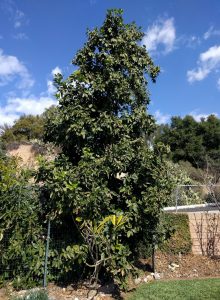
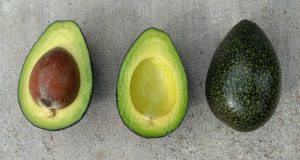
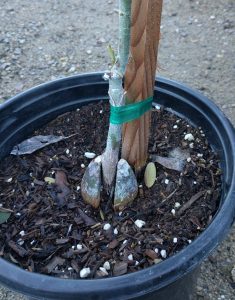
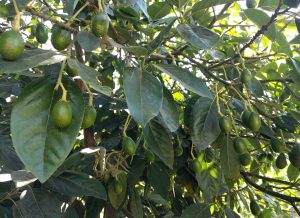
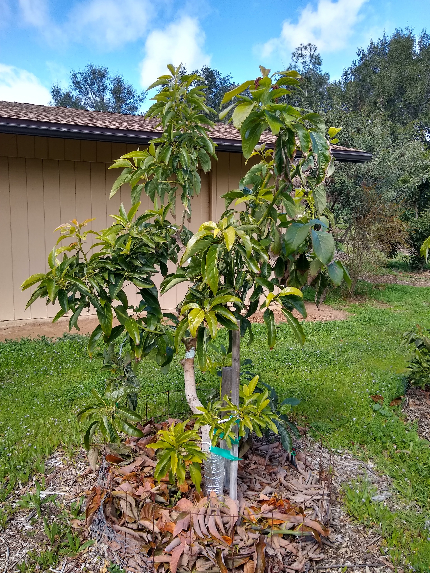


Hi Greg, Well written and thought out. I had been thinking of the Hass pollination you’d mentioned to me, and was going to ask you for it. You did in this post! The older lists were interesting to read over (Popenoe was quite a character), and I have one that’s in both: Fuerte. Thanks, Robert
PD Error was operator error!
Thanks Robert!
I was thinking of mentioning that Fuerte is the only variety that is not only mentioned in both of those century-old lists but also still commonly grown today. That’s some serious staying power.
I too love reading everything Popenoe wrote. Incidentally, I just read his account of his first visit to the parent Fuerte tree, which includes a photo of it.
Thanks a lot Greg
Very interesting information
Hi Greg,
I am a novice avocado grower and have asked a few questions here before. I have really appreciated your articles and videos. I find the advice really practical for the casual (or advanced) home grower.
Anyway, I purchased and planted my first two trees, Reed and Hass of course, a couple months before the record heat wave in July. The reed proved quite resilient and looks to be fairing rather well, the Hass, not so much. I worry the Hass may have died, but have tried nursing it through the past few months. There has yet to be new growth, but are some leaves holding on despite the harsh burns they received. Wondered if I could maybe enlist your experienced eye and get an opinion. Thanks again for the great content and happy holidays!
Hi William,
Thanks for the comments. Good to hear that your Reed made it through the heat. Sorry about the Hass. My Reed did far better than my Hass last summer too.
Do you mean to say that your little Hass hasn’t grown any new leaves since the July heat? If so, that’s a bad sign. You may want to give it the chance of a spring flush and then decide whether to continue nursing it. If it doesn’t put out a bunch of new leaves by April, then plant a new Hass. Also, beware of cold nights: a damaged young tree like yours is more susceptible to cold temperatures than healthier or larger avocado trees. (In case you haven’t already, see my post, “Protecting avocado trees from cold.”)
If you’d like to send me a photo of the tree, feel free: greg@gregalder.com
Thanks Greg, I sent some photos over. I have lights strung throughout both of my trees, Christmas themed to boot. So far the lowest it’s projected to be is 35 degrees so I am hopeful the lights will be fine for now!
In any case, I appreciate the help!
Hi William (5 years later, so i assume you have fund out about your Hass.) I just want to add for others, I live in Humboldt County in a 9b zone. Last winter we had snow on the ground – rare. Lots of days in the low 40’s and nights in the 30’s. My 5 year old Hass (on Zutano) hasn’t produced and this past spring I thought it was done. The only protect i do is covering the 4’x4′ raised beBut by late April I saw swollen buds a few little shoots. By June she was bushier than before. The point, Hass is a LOT stronger than reported. The only protection I give to the Hass in a 4’x4’x1′ raised bed is covering the bed in heavy gauge white/black plastic, black side up to absorb whatever heat and shed the heavy rains we get up here in winter.
Good luck all.
Greg
Thanks very much for directing me to this post about your
Mom’s seedling avocado tree born from a Hass seed. Your Moms tree looks very much like my tree also grown from a Hass seed. Columnar shape and pear shaped fruit very light green, very smooth skin with sparkly stars.
I’ll email you a couple pics from Northridge.
Why do people graft avocado seedlings instead of rooting scions?
Hi Monty,
Avocado cuttings don’t root easily, and often you want a certain type of avocado to use for rootstock (because it has resistance to soil salinity, for example) while you want another type of avocado for the scion (because of the good fruit, of course).
Hello!
A very informative article to read. I was interested to find even approximation of what avocado tree you’d be getting from a pit… wonder if avocados have more or less variations than apples, though~ 😉
I sprouted one from rather large green fruit – it took like a month to germinate.
I have one pit from a small green avocado that does nothing still (I think it’s been more than a month already~)
And I have a really big round wrinkley seed, compared to two mentioned above, from a big black-reddish skinned fruit that cracked in TWO days! I mean, everywhere I read it said avocados take at least a month to sprout, so I was really surprised by that seed (also the flavor of that fruit was surprisingly tasty to me too – I honestly hate avocados myself, btw lol, my mom occasionally eats them). Therefore, I have high hopes for that last seed (there’s another one of the same waiting for me not eaten yet^^).
Cheers!
Hi Greg, thanks for the post. Quite interesting to understand why it is important to use grafted plants for commercial production.
My neighbor has an avocado tree. I got 2 avocados from a branch that grew on my property side..its the best tasting avocado I have ever had.. I would like to grow the seeds…and get the same tasty avocado ..problem is, my neighbor will not share a piece of branch for grafting nor will he let anyone have for free or buy an avocado from his tree..the avocado is a rare kind which I can’t guess the variety it is…my question here is…can I grow the seed and use a different variety of avocado to graft? Will the new grafted tree taste like the original avocado from the seed
Only if you graft a branch from that particular tree will you get the same avocados. I might suggest that if a few avocados are hanging over on your side of the fence, then a branch is likewise on your side of the fence. And any tree overhang into your property is fair game (and I think completely legal) to cut. If you happened to take one of those cuttings to a skilled grafter who had a tree ready to graft, well then, you could end up growing the exact same avocado!
Thanks, Dan! My thoughts exactly.
Greg my wife started a seedling years ago I planted it in the yard around 2005 it produces fruit thersmall in size and tasty how’s the best way to determine the type of fruit it produces
At what point should asprouted avocado pit be planted in the ground? I have several, in pots, some 3 or 4 feet tall with multiple hardy branches. How should I prep the ground and how far apart should they be? (I live in Laurel Canyon in Los Angeles and one avocado tree on our property took over 10 years before it produced anything,but was abundant during the pandemic and is covered with large delicious thick green skinned avocados now…I’ve been sprouting its pits).
what are the dark lines which grow in the meat of the fruit
Hi Tom,
Those are called by different names: fibers, strings, vascular bundles. Their function is similar to that of veins in people. They feed water and nutrients to the growing fruit.
Notice that they come together at the top where the stem is (to connect to the tree) and also at the bottom of the seed (which is the heart and purpose of the fruit).
Hi
I have a Reed tree that was grafted onto a hass rootstock. it is 20 years old and produces plenty of beatiful fruit. I have grown seedling form the fruit, can I graft a scion from the parent tree to the rootstock of her seedlings, thanks
Hi Tony,
Yes, you can graft the Reed scion onto the Reed seedling rootstocks, and then you’ll get Reed fruit from those trees.
What type of scion avocado is grafted to a hass scion ?
I should have read what you had written on what Bergh had stated it is impossible to tell, so I will call it a seedling. I’m still learning about avacodas and enjoy your post about them
Hi Greg,
Great article. Keep up the good work.
I’m curious to start experimenting with growing fruits from seed – apples, avocados, etc. In your experience, have you noticed that the trees you’ve let grow from seed in their original location (i.e. sown directly into the ground and never transplanted) demonstrate any more resilience or drought tolerance, vs transplanted seedlings or nursery stock?
I’m wondering if there is any advantage of allowing that tap root to grow and develop undisturbed.
Hi Eugene,
Thanks. This is so hard to tell. I do have many seedlings growing in place that seem tough, but I don’t have transplanted trees next to them for a good comparison. I understand the appeal of the idea that having that taproot will help, but I just can’t say that I’ve seen clear evidence that it actually does.
A few years ago, I planted some seeds to be used for rootstocks, thinking I would graft them in place and the taproot would help as you mentioned, but they didn’t germinate well and I abandoned them. It’s not so easy to germinate avocado seeds out in the open compared to under some shade in a container.
Hi Greg,
Buying grafted avocados is extremely expensive at the main supplier here in Australia which is a local hardware chain so I am going to try seeds. Previously I understood seeds to be a waste of time so thank you for your informative articles. We have had one of the wettest years on record and I have lost several of my grafted trees. I have now learned that firstly avocados do not like wet feet and secondly cannot be moved to a drier area after an initial planting. Also sellers do not tell homeowners not to plant Hass or Sharwill owing to their size being too large for city gardens. After a lot of learning it seems that Wurtz is the absolute best for our purpose being both A and B flowering at the same time. Surely this variety is perfect for city dwellers but I never see much discussion of it. NB Your information has been more helpful than all I have read previously.
Russell, a thought or two if you don’t mind some comments from the peanut gallery.
Wurtz is probably the smallest dwarf, but it isn’t the only small tree. GEM is a great tree that stays pretty compact. Plus, the avos are great! Lamb is also a small-ish tree with great fruit. And if you can have a taller tree that doesn’t spread (ie, columnar), Reed is one of my favorite avos. There probably isn’t a lot of discussion about the Wurtz because small is its best characteristic.
Depending on where you are located and your temperature patterns, most A types can have both male and female flowers open at the same time which will allow them to self pollinate (ie, behave like an A type and a B type at the same time). If you have flooding issues, well, plant high. If you can’t plant high, plant on a large mound of fast draining soil (I mix mulch, a little sand and native soil). Greg has some great articles on best practices for planting here.
Good luck!
Hi Greg! Thank you for all your great articles on avocados! I live on the coast in Southern California and have 2 reed avocado trees and 2 fuerte. One fuerte is a 25+ foot, 15 year old seedling, producing its first avocado last year. The other fuerte is a grafted 7 year old tree, producing 2 very small inedible avocados last year. The grafted reeds are 20 year olds and produce 1-2 each year. I’m sure there are a few reasons for really no fruit being produced, including being so close to the ocean. I have many questions, including the need to prune the large seedling as it is above the community’s allowed height. Do you have anyone you could suggest in Orange County area that would be able to visit us and give recommendations?
Hello Greg!
Thank you for your post, it is very informative and easy to follow. I am growing a Reed Avacado seed in a large pot outside in the garden. The leaves are large and healthy, its trunk part is also full of leaves (even though I did not cut it in half while it was growing).
Can the Reed seedling grow large avocados (like the original Reed Tree), or can it be anything unpredictable like in the Hass research?
What are the fruit characteristics to fully confirm that the tree can be patent? Does Reed seedling also take longer like 10 years, or do they tend to give fruit sooner, maybe around 5 years?
Please advise.
Thank you,
Hi, very interesting read. While Hass seedlings will have great genetic variety, one thing neither your post nor the “Self-pollinated Hass seedlings” paper mentioned is whether the seedlings will be A- or B-type trees. Will all Hass seedlings be type-A, like the Hass? Will it be a 50-50 mix, depending on the father variety? Will e.g. all Hass-mother/Bacon-father seedlings be of the same type, or will it vary from seedling to seedling? Thanks in advace!
I have an avocado plant I plan on transplanting this spring. Do the half- seeds at the base go with the plant? Do they fall off?
It looks as if the stem itself goes into the soil, and I figured that it had the roots. Should I be concerned about the seed halves?
Hi Laura,
Cool question. Those halves of the seed are technically called the cotyledons, and they are an energy source for the sprouting plant. But after the seed has sprouted and has roots and a number of leaves, the cotyledons are no longer needed because the little tree can produce energy for itself.
It’s best to just leave the seed halves be. They will shrivel, brown, and decompose on their own, right there at the base of the new tree.
Hi Greg, I love your website and have learned a lot from it.
A few years ago, I planted a HAAS, a Fuerte, and a seed from a Reed (out of curiosity). The HAAS and Fuerte have fruited in prior years. The seedling Reed is twice as tall but just flowered for the first time (all flowers dropped before my other trees had flowers).
I recently read a detailed, multi-year pollination study by Thomas L. Davenport, under BARD Project No. US-3345-02R. For the study, he tented trees to keep bees OUT of the trees. He then inspected the flowers and fruit…surprisingly, 95% of the tented trees’ flowers and fruits were cross-pollinated! The percent was identical to that of the untented trees. The gist of the 20-page report is airborne pollen is more important than bees.
Based on Davenport’s report, my Fuerte would be a better pollinator of my HAAS if it was upwind of the Haas.
Maybe 2025 is an oddity, but my Fuerte concurrently opens both male and female flowers, everyday for the past two weeks. Are your Fuertes doing the same thing? [I am in SoCal].
What’s the difference between ma,e and female flowers? How do you recognize them? Do they all turn into avocados?